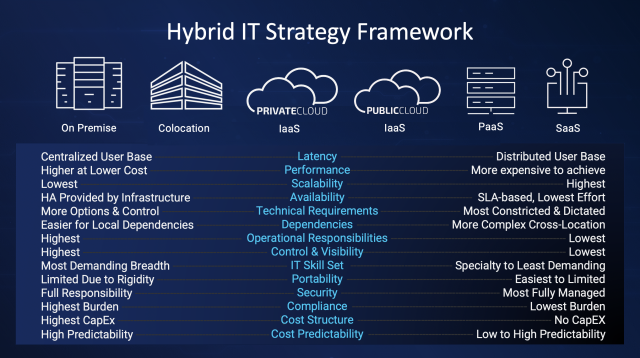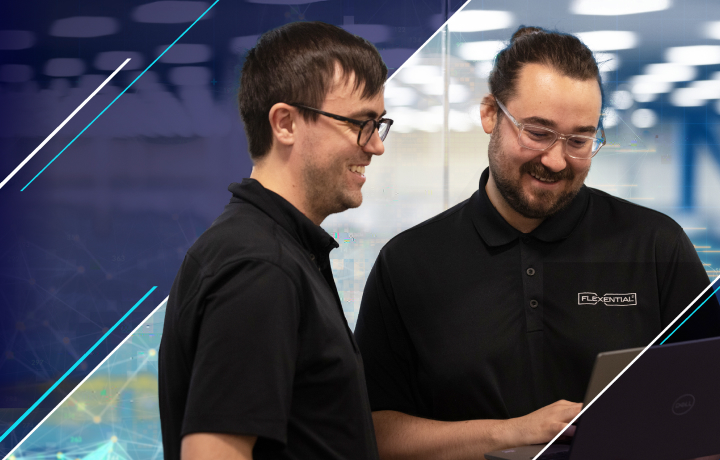How to decide what should live where
In a recent blog post, we described the fundamental differences of various workload placement locations and talked about how vital it is to understand those differences before choosing to place workloads in a cloud…or whether to put them there at all.

The six types of locations we listed—on-premises, colocation, hosted private cloud, public cloud, platform-as-a-service (PaaS) and software-as-a-service (SaaS)—offer a wide range of benefits, limitations and risks. Given the many options, it’s crucial to understand their differences and create your hybrid IT strategy before placing workloads and committing time and money to a new environment.
Determining optimal workload placement requires understanding the technical, operational and financial implications of a placement decision for a given workload. Flexential Professional Services developed a Hybrid IT Strategy Framework for advising on optimal workload placement. The framework includes 14 criteria for evaluating workloads to decide which hybrid IT placement option best fits a given workload. It takes a bit of work to examine each workload against each criterion, especially when there are many workloads under consideration. Still, careful upfront analysis saves substantial time, trouble and money.
Hybrid IT workload placement criteria
Let’s take a quick look at the criteria that should drive hybrid IT workload placement decisions.
Technical criteria
Latency: Latency-sensitive workloads should be placed as geographically close as possible to users, as geographical distance is a significant factor affecting latency. On-premises solutions are best suited to cases where users are local and centralized. SaaS-type solutions are well-suited for widely dispersed users. Latency requirements should be identified, and latency should be measured ahead of workload placement to prevent surprises.
Performance: Compute and network performance is a combination of computing capacity, storage speeds, and bandwidth. While high performance can be obtained in multiple ways, it is most reliable when using purchased purpose-built equipment that resides on-premises or in colocation or dedicated hardware and reserved compute power from cloud providers.
Scalability: Cloud-based implementations allow computing and storage resources to scale dynamically, and with metered pricing, organizations only pay for what they use. Public cloud platforms are well suited to workloads that need to “scale out” through microservices or automated deployment or “scale-up” with computing resources.
Availability: When an application is designed, developed, and built for a specific platform, it can leverage that platform’s native features for high availability (HA), such as load balancing or clustering. This often requires additional computing resources to facilitate HA at increased costs. Clouds can provide infrastructure HA at the hypervisor layer by leveraging redundant compute, network, and storage, usually at a lower cost than dedicated hardware.
Technical Requirements: Technical requirements include computing resources, performance requirements, licensing considerations, and the appropriate placement of specialized appliances or physical equipment. Some workloads must remain on specialized hardware or are limited to specific placements and service options.
Dependencies: Sufficient connectivity to dependent components must be considered in workload placement decisions. Interconnectivity complexity increases when dependencies span different environments and locations.
Operational criteria
Operational Responsibilities: Outsourcing infrastructure, applications or services shifts operational responsibility to a third party and frees up internal IT resources, but when a service impact event occurs, clarity on who is responsible for resolution becomes crucial.
IT Skill Set: An honest assessment of internal skill sets is necessary to identify training needs. A lack of internal IT skills is also an opportunity to consider leveraging external vendors to fill team or department knowledge gaps. Once an assessment is done, IT can prioritize the skill gaps to fill in-house, what skills to de-prioritize, and the extent of third-party services needed.
Portability: The ease of moving a workload from one environment to another becomes a critical criterion when performing lifecycle management activities such as hardware or software refreshes, changing service providers or changing workload placement closer to users. Containerization can make portability more straightforward, but not every workload is a good container candidate.
Control and Visibility: Keeping workloads highly accessible to IT staff for reliable, transparent and consistent service management is one reason organizations invest in on-premises or colocated solutions. Familiarity and knowledge of platforms, operational processes and system lifecycles increases confidence and predictability during planned maintenance or unplanned disruptions.
Security: Cloud solutions include a suite of technical and procedural security controls, but organizations will still have some security responsibilities in any solution—even if it’s only user access controls for a SaaS application. Security visibility, auditability and testability are necessary for tracking and validating changes and managing risk, and each placement option offers different security benefits and limitations.
Compliance: Organizations must have sufficient controls, auditability and attestations to maintain compliance with standards, rules and regulations. While cloud providers maintain compliance with many regulations, each customer is ultimately responsible for compliance and must confirm a chosen vendor meets their specific requirements.
Financial criteria
Cost Structure: Cloud computing allows shifting budgets toward OPEX with third-party services and subscriptions and dramatically decreasing CAPEX spend. CAPEX-based approaches frequently involve inflexible, longer-term financial positions that engender investment risk for capital-intensive infrastructure.
Cost Predictability: With cloud-based automatic scaling and ease of provisioning comes shorter deployment and development cycles, as well as an increased risk of runaway costs. Hyperscale clouds, in particular, require a greater degree of cost management than traditional physical server-based environments or more closely controlled private clouds.
Strategizing for hybrid IT success
When considering hybrid IT options, remember to start with a workload point of view. Workloads drive platform and infrastructure requirements, not the other way around.
Analyzing workloads individually identifies the primary technical, operational, and financial drivers for a placement location decision and the broader infrastructure and services landscape required. It can take some work, but it will be well worth the time spent. Organizations that approach hybrid IT decision-making with a workload perspective can achieve greater flexibility, scalability, security, and lower IT costs, putting them on a path to meet business goals. In your current landscape, do all your workloads currently reside in locations that deliver the needed performance, security, reliability, and user experience? Do you currently have a documented cloud or hybrid IT strategy, or are you making ad hoc or reactive decisions?
To learn more about workload placement and how to achieve hybrid IT success, download our white paper, on how to use workload placement to optimize your hybrid IT strategy.








